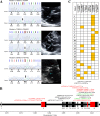Deleterious variants in DCHS1 are prevalent in sporadic cases of mitral valve prolapse
- PMID: 29224215
- PMCID: PMC5823682
- DOI: 10.1002/mgg3.347
Deleterious variants in DCHS1 are prevalent in sporadic cases of mitral valve prolapse
Abstract
Background: A recent study identified DCHS1 as a causal gene for mitral valve prolapse. The goal of this study is to investigate the presence and frequency of known and novel variants in this gene in 100 asymptomatic patients with moderate to severe organic mitral regurgitation.
Methods: DNA sequencing assays were developed for two previously identified functional missense variants, namely p.R2330C and p.R2513H, and all 21 exons of DCHS1. Pathogenicity of variants was evaluated in silico.
Results: p.R2330C and p.R2513H were not identified in this cohort. Sequencing all coding regions revealed eight missense variants including six considered deleterious. This includes one novel variant (p.A2464P) and two rare variants (p.R2770Q and p.R2462Q). These variants are predicted to be deleterious with combined annotation-dependent depletion (CADD) scores greater than 25, which are in the same range as p.R2330C (CADD = 28.0) and p.R2513H (CADD = 24.3). More globally, 24 of 100 cases were carriers of at least one in silico-predicted deleterious missense variant in DCHS1, suggesting that this single gene may account for a substantial portion of cases.
Conclusion: This study reveals an important contribution of germline variants in DCHS1 in unrelated patients with mitral valve prolapse and supports genetic testing of this gene to screen individuals at risk.
Keywords: DCHS1; deleterious variants; genetics; mitral valve prolapse; sequencing.
© 2017 The Authors. Molecular Genetics & Genomic Medicine published by Wiley Periodicals, Inc.
Figures

Similar articles
-
Report of a rare case of congenital mitral valve prolapse with chronic kidney disease--reconsidered genotype-phenotypic correlations.Mol Genet Genomic Med. 2021 Jan;9(1):e1558. doi: 10.1002/mgg3.1558. Epub 2020 Nov 22. Mol Genet Genomic Med. 2021. PMID: 33225636 Free PMC article.
-
Mutations in DCHS1 cause mitral valve prolapse.Nature. 2015 Sep 3;525(7567):109-13. doi: 10.1038/nature14670. Epub 2015 Aug 10. Nature. 2015. PMID: 26258302 Free PMC article.
-
Mutation in mitral valve prolapse susceptible gene DCHS1 causes familial mitral annular disjunction.J Med Genet. 2024 Jan 19;61(2):125-131. doi: 10.1136/jmg-2023-109278. J Med Genet. 2024. PMID: 37399314
-
Genetic background of mitral valve prolapse.Rev Cardiovasc Med. 2022 Mar 12;23(3):96. doi: 10.31083/j.rcm2303096. Rev Cardiovasc Med. 2022. PMID: 35345263 Review.
-
Mitral Valve Prolapse: Multimodality Imaging and Genetic Insights.Prog Cardiovasc Dis. 2017 Nov-Dec;60(3):361-369. doi: 10.1016/j.pcad.2017.10.007. Epub 2017 Nov 6. Prog Cardiovasc Dis. 2017. PMID: 29122631 Free PMC article. Review.
Cited by
-
DCHS1, Lix1L, and the Septin Cytoskeleton: Molecular and Developmental Etiology of Mitral Valve Prolapse.J Cardiovasc Dev Dis. 2022 Feb 17;9(2):62. doi: 10.3390/jcdd9020062. J Cardiovasc Dev Dis. 2022. PMID: 35200715 Free PMC article.
-
Differential Development of the Chordae Tendineae and Anterior Leaflet of the Bovine Mitral Valve.J Cardiovasc Dev Dis. 2024 Mar 29;11(4):106. doi: 10.3390/jcdd11040106. J Cardiovasc Dev Dis. 2024. PMID: 38667724 Free PMC article.
-
Mitral Valve Prolapse: A Disease of Valve and Ventricle.J Am Coll Cardiol. 2018 Aug 21;72(8):835-837. doi: 10.1016/j.jacc.2018.07.006. J Am Coll Cardiol. 2018. PMID: 30115221 Free PMC article. No abstract available.
-
The Potential of Intertwining Gene Diagnostics and Surgery for Mitral Valve Prolapse.J Clin Med. 2023 Nov 30;12(23):7441. doi: 10.3390/jcm12237441. J Clin Med. 2023. PMID: 38068501 Free PMC article. Review.
-
Non-syndromal mitral valve prolapse (MVP): a common entity, but not commonly associated with DCHS1 or FLNA mutations.J Thorac Dis. 2022 Jun;14(6):2440-2442. doi: 10.21037/jtd-22-173. J Thorac Dis. 2022. PMID: 35813742 Free PMC article. No abstract available.
References
-
- Adzhubei, I. A. , Schmidt, S. , Peshkin, L. , Ramensky, V. E. , Gerasimova, A. , Bork, P. , … Sunyaev, S. R. (2010). A method and server for predicting damaging missense mutations. Nature Methods, 7, 248–249. https://doi.org/10.1038/nmeth0410-248 - DOI - PMC - PubMed
-
- Bachmann, H. S. , Siffert, W. , & Frey, U. H. (2003). Successful amplification of extremely GC‐rich promoter regions using a novel ‘slowdown PCR’ technique. Pharmacogenetics, 13, 759–766. https://doi.org/10.1097/00008571-200312000-00006 - DOI - PubMed
-
- Choi, Y. , Sims, G. E. , Murphy, S. , Miller, J. R. , & Chan, A. P. (2012). Predicting the functional effect of amino acid substitutions and indels. PLoS One, 7, e46688 https://doi.org/10.1371/journal.pone.0046688 - DOI - PMC - PubMed
-
- den Dunnen, J. T. , Dalgleish, R. , Maglott, D. R. , Hart, R. K. , Greenblatt, M. S. , McGowan‐Jordan, J. , … Taschner, P. E. (2016). HGVS recommendations for the description of sequence variants: 2016 update. Human Mutation, 37, 564–569. https://doi.org/10.1002/humu.22981 - DOI - PubMed
-
- Durst, R. , Sauls, K. , Peal, D. S. , deVlaming, A. , Toomer, K. , Leyne, M. , … Slaugenhaupt, S. A. (2015). Mutations in DCHS1 cause mitral valve prolapse. Nature, 525, 109–113. https://doi.org/10.1038/nature14670 - DOI - PMC - PubMed
Publication types
MeSH terms
Substances
Associated data
- Actions
Grants and funding
LinkOut - more resources
Full Text Sources
Other Literature Sources
Medical

